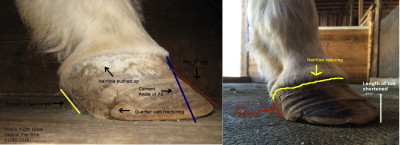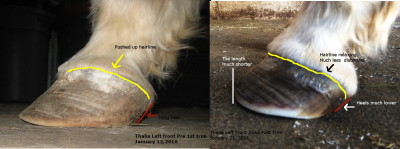Thalia’s Front Hooves: 2wks and the Rehab is happening
These photos illustrate how the horse grows a new hoof with correct mechanics if it is set up by the trimmer to heal itself.
Thalia’s front hooves were first trimmed by me 2 weeks ago on January 12. I waited 2 weeks and did a touch-up trim on those front hooves today and took new photos. I am very pleased with her progress. She has a long way to go but good stuff is happening.
Of particular note please notice how the hairline is starting to achieve a smooth straight slope to the ground if viewed laterally (from the outside). The bulge in the hairlines in both the right and left front heels will not disappear until a tighter laminae connection is made further down the hoof wall as it grows out. This tighter connection will “lift” the coffin bone back into the correct position within the hoof capsule , lowering the now elevated back wings of the coffin bone and leveling the bottom of the coffin bone, and she will achieve concavity and straight hairlines in her front hooves as this happens.
A couple of things in her favor for a sooner rather than later recovery, she has very strong bulbs and frogs at the back of her hooves on all 4 hooves. This allows me to continue to lower the heel hight on the front to help get the coffin bone back level with the ground (or close to it). I’m only lowering those heels and the frog approximately 1/8th inch every 2 weeks. She no doubt has has high heels for a lifetime and she needs time to stretch those tendons.
In addition to having a strong rear part of the hoof it is winter. And the cold temps help keep any inflammation under control as I alter her mechanics. She is the one wishing for lots of snow!!!
Please also note that you cannot heal laminitis without attending to the diet in addition to hoof mechanics. She has been placed on a low sugar and low starch, < 10%, basically hay diet (I have my hay tested so I know it is low sugar and low starch) with just the supplements she needs to balance the major and trace minerals in the hay.
She is doing splendidly. I couldn’t be happier with her progress. She was a total peach for the quick trim I did today. These laminitic horses can be hard to trim because bearing full weight on one of those fronts is painful for them. The fact she wasn’t pulling away today says we are headed in the right direction!


I am fascinated by this series and the work you are doing with Thalia. She is lucky to have you.
Thank you Yatima! I have rehabilitated laminitic feet with rotation and sinking in the past and I don’t suggest anyone to do anything I haven’t tried myself on MY horses. Thalia came along at the right time. She is benefiting from all I’ve learned over the past 16 years I’ve been trimming my horses’ hooves and solving laminitis problems along the way.
Note that supplement of magnesium might be important to avoid new lamenitis in future
Patrick, Thank you for your suggestion. It isn’t only magnesium that is important, it is the entire diet. The major and trace minerals must be balanced tightly for an IR horse. You can feed as much magnesium as you want but if your major minerals are not balanced correctly with each other then your horse won’t assimilate the magnesium you supplied. Equally important to balancing the major and trace mineral intake, the starch + ESC (Ethanol Soluble Carbohydrates also known as Simple Sugars) needs to be kept at less than 10% for the entire diet. Testing pasture or hay becomes exceedingly important since that makes up the bulk of the diet.
My horse suffer from frequent hoof cracks before but with proper feed and hoof maintenance, all went well and the cracks never returned.